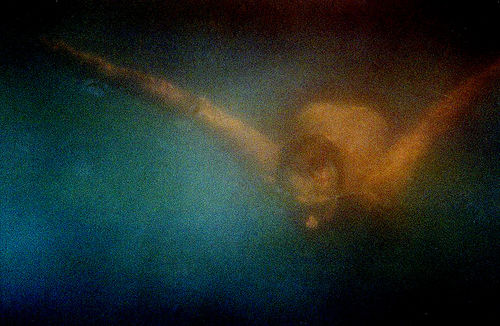 Momus is a Scottish pop musician, based in Berlin, who writes smart and original things about art and technology. He blogs a wonderful blog called Click Opera — some of the best reading on the web. He wears an eye patch. And he is currently doing a stint as an “unreliable tour guide” at the Whitney Biennial, roving through the galleries, sneaking up behind museum-goers with a bullhorn.
Momus is a Scottish pop musician, based in Berlin, who writes smart and original things about art and technology. He blogs a wonderful blog called Click Opera — some of the best reading on the web. He wears an eye patch. And he is currently doing a stint as an “unreliable tour guide” at the Whitney Biennial, roving through the galleries, sneaking up behind museum-goers with a bullhorn.
A couple of weeks ago, Dan had the bright idea of inviting Momus — seeing as he is currently captive in New York and interested, like us, in the human migration from analog to digital — to visit the institute. Knowing almost nothing about who we are or what we do, he bravely accepted the offer and came over to Brooklyn on one of the Whitney’s dark days and lunched at our table on the customary menu of falafel and babaganoush. Yesterday, he blogged some thoughts about our meeting.
Early on, as happens with most guests, Momus asked something along the lines of: “so what do you mean by ‘future of the book?'” Always an interesting moment, in a generally blue-sky, thinky endeavor such as ours, when you’re forced to pin down some specifics (though in other areas, like Sophie, it’s all about specifics). “Well,” (some clearing of throats) “what we mean is…” “Well, you see, the thing you have to understand is…” …and once again we launch into a conversation that seems to lap at the edges of our table with tide-like regularity. Overheard:
“Well, we don’t mean books in the literal sense…”
“The book at its most essential: an instrument for moving big ideas.”
“A sustained chunk of thought.”
And so it goes… In the end, though, it seems that Momus figured out what we were up to, picking up on our obsession with the relationship between books and conversation:
It seems they’re assuming that the book itself is already over, and that it will survive now as a metaphor for intelligent conversation in networks.
It’s always interesting (and helpful) to hear our operation described by an outside observer. Momus grasped (though I don’t think totally agreed with) how the idea of “the book” might be a useful tool for posing some big questions about where we’re headed — a metaphorical vessel for charting a sea of unknowns. And yet also a concrete form that is being reinvented.
Another choice tidbit from Momus’ report — the hapless traveler’s first encounter with the institute:
I found myself in a kitchen overlooking the sandy back courtyard of a plain clapperboard building on North 7th Street. There were about six men sitting around a kidney-shaped table. One of them was older than the others and looked like a delicate Vulcan. “I expect you’re wondering why you’re here?” he said. “Yes, I’ve been very trusting,” I replied, wondering if I was about to be held hostage by a resistance movement of some kind.
Well, it turned out that the Vulcan was none other than Bob Stein, who founded the amazing Voyager multi-media company, the reference for intelligent CD-ROM publishing in the 90s.
He took this lovely picture of the office:

Interestingly, Momus splices his thoughts on us with some musings on “blooks” (books that began as blogs), commenting on the recently announced winners of lulu.com‘s annual Blooker Prize:
What is a blook? It’s a blog that turns into a book, the way, in evolution, mammals went back into the sea and became fish again. Except they didn’t really do that, although undoubtedly some of us still enjoy a good swim.
And expanding upon this in a comment further down:
…the cunning thing about the concept of the blook is that it posits the book as coming after the blog, not before it, as some evolutionist of media forms would probably do. In this reading, blogs are the past of the book, not its future.
To be that evolutionist for a moment, the “blook” is indeed a curious species, falling somewhere under the genus “networked book,” but at the same time resisting cozy classification, wriggling off the taxonomic hook by virtue of its seemingly regressive character: moving from bits back to atoms; live continuous feedback back to inert bindings and glue. I suspect that “the blook” will be looked back upon as an intriguing artifact of a transitional period, a time when the great apes began sprouting gills.
If we are in fact becoming “post-book,” might this be a regression? A return to an aquatic state of culture, free-flowing and gradually accreting like oral tradition, away from the solid land of paper, print and books? Are we living, then, in an age of amphibians? Hopping in and out of the water, equally at home in both? Is the blog that tentative dip in the water and the blook the return to terra firma?

But I thought the theory of evolution had broken free of this kind of directionality: the Enlightenment idea of progress, the great chain gang of being. Isn’t it all just a long meander, full of forks, leaps and mutations? And so isn’t the future of the book also its past? Might we move beyond the book and yet also stay with it, whether as some defined form or an actual thing in our (webbed) hands? No progress, no regress, just one long continuous motion? Sounds sort of like a conversation…

